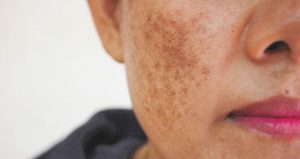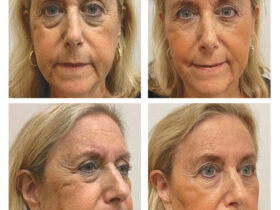By Dr. Anne Marie Tremaine
 Melasma is a common, stubborn, and recalcitrant skin condition that typically effects pre-menopausal women and is characterized by brown patches on sun exposed areas, specifically the face. These asymptomatic brown patches are usually symmetric and with irregular borders. Melasma is not harmful, but a cosmetic nuisance.
Melasma is a common, stubborn, and recalcitrant skin condition that typically effects pre-menopausal women and is characterized by brown patches on sun exposed areas, specifically the face. These asymptomatic brown patches are usually symmetric and with irregular borders. Melasma is not harmful, but a cosmetic nuisance.
The most common triggers for melasma include hormones (estrogen and progesterone), birth control pills, ultraviolet light, visible light, and heat. Melasma is often called the “mask of pregnancy” because it is commonly triggered by the hormonal changes associated with pregnancy.
Melasma is something that we treat, but do not cure. The treatments improve melasma, however, further exposure to triggers is likely to cause a recurrence. Florida is unfortunately a difficult place to treat melasma because even exceedingly small doses of light (for example, walking to the car/mailbox) is enough to further worsen the hyperpigmentation. That being said, persistence with a good skin care regimen, proper treatment, and sun avoidance will keep melasma under control.
Thankfully, there are numerous treatment options and I will cover some of them today. The most important treatment is sunscreen and sun avoidance!!!! Avoiding the sun and heat is paramount. In addition to sunscreen, wide brim hats, sunglasses, and neck gaiters are extremely helpful. There are also full-face visors for those looking to go the extra mile.
A thoughtfully crafted topical regimen is critical to treatment success. Again, the first step is daily sunscreen application. The best sunscreen for melasma is one containing iron oxides (typically a tinted zinc-based sunscreen). There are different topicals that reduce hyperpigmentation, including, but not limited to antioxidants (SkinCeuticals CE Ferulic and Phloretin CF), tranexamic acid (SkinCeuticals Discoloration Defense), hydroquinone, kojic acid, azelaic acid, alpha/beta hydroxy acids, and retinols. Heliocare is an oral herbal supplement, derived from the Polypodium leucotomos fern plant. When taken daily, it works in conjunction with your sunscreen to block the effects of UV light. Light to medical depth chemical peels are also effective for treating melasma, and there are many options, including alpha hydroxy acids, beta hydroxy acids, and trichloroacetic acid (TCA). Finally, laser and light-based devices can be used to treat melasma but must be used with caution. If the laser settings are too aggressive, they can cause worsening of the pigmentation. Although melasma is a chronic condition, it can be managed with the help of your dermatologist
Anne Marie Tremaine, MD
Board Certified Dermatolgist
Harvard Cosmetic and Laser Medicine Fellowship
Dr. Tremaine is a board-certified dermatologist with fellowship training at Harvard Medical School in laser and cosmetic dermatology. She has contributed as a dermatology expert for online and print magazines including Family Fun, msn.com, menshealth.com, and ccn.com. In addition, she frequently lectures to professional societies on her diverse research. For more information about skin care, visit the Skin Wellness Physicians website at: www.skinwellnessflorida.com
Skin Wellness Physicians
239.732.0044
www.skinwellnessflorida.com









